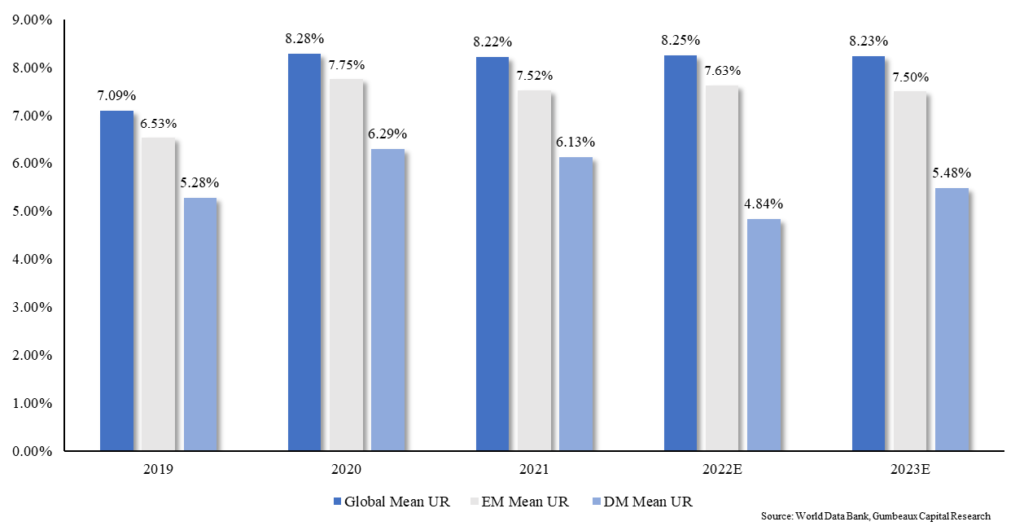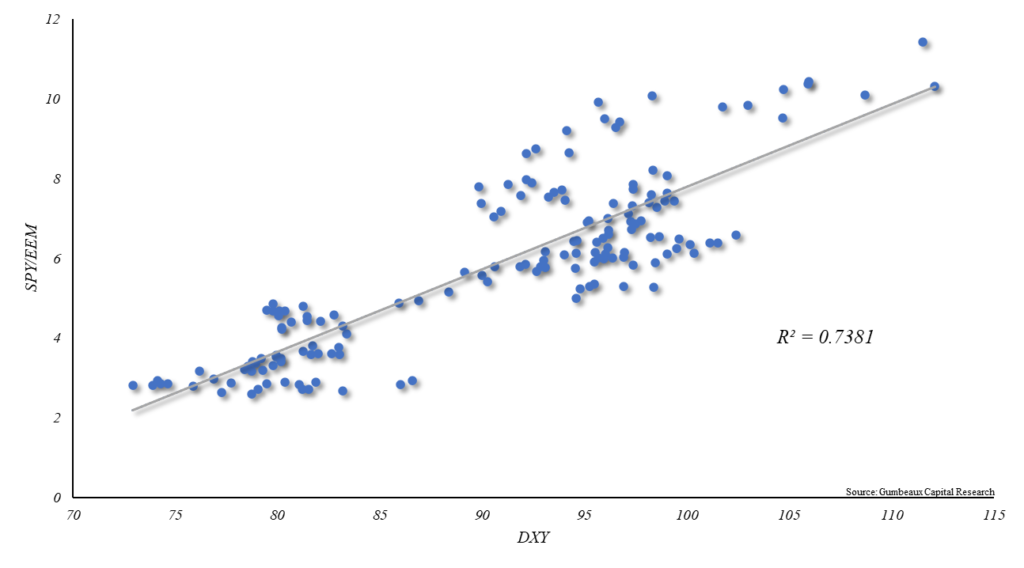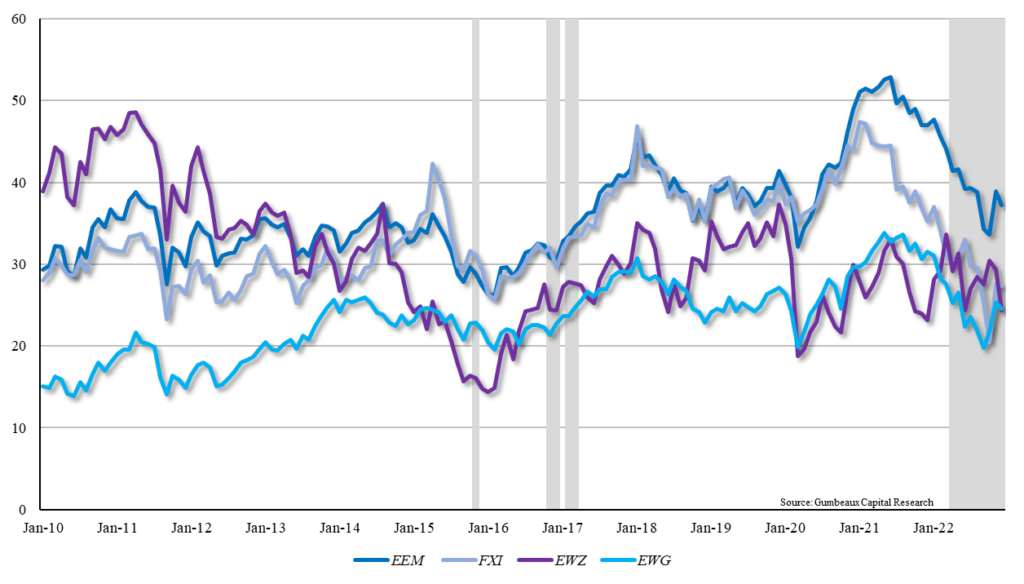In 2022 we observed lower valuations across global markets and asset classes. The catalysts of this dynamic can be attributed to the fears of global recession, higher global inflation, strengthened USD, and higher cash rates. As these dynamics continue to build through the end of 2022, investors will continue to be faced with nuanced headwinds throughout 2023 but will have more opportunities to harvest yield.
The headwinds that we expect to persist throughout 2023 will be derived from the “re-emergence” of the Phillips Curve as we see central banks continue to relentlessly fight inflation. Regarding inflationary pressures, we expect the aggregate central bank regime to tame inflation, but we believe that the post-COVID inflation has become sticky leaving us with relatively higher price levels going forward. Moreover, we observe through our projections that we can expect to see a larger delta for sticky inflation in developed markets versus emerging markets (see Exhibit A).
Exhibit A: While we expect inflation to “cool”, we also expect relatively higher price levels for the long haul.

While price levels looked to have peaked in the latter half of 2022 via monetary policy shifts where we saw central banks across emerging and developed markets raise interest rates (see Exhibit B), many investors now have eyes on the effects that such a shift will impose on the broader economy going forward. With respect to the Phillips Curve, we want to take into account unemployment figures. Throughout 2022, as we start to see inflation cool off, we expect to see slightly elevated levels of unemployment 2022 across the broader economy (see Exhibit C). In 2023 we expect to see polarizing results for developed markets versus emerging markets which signals that we will see further convexity within the emerging markets Phillips Curve, but slightly increased concavity for the developed markets Phillips Curve.
Exhibit B: Central banks have collectively raised interest rates in pursuit of policy normalization.

Exhibit C: Our expectations for mean unemployment figures suggest polarizing Phillips Curve outcomes for developed markets and emerging markets.

Derived from our projections of the Philips Curve, we expect global growth figures to follow in line notwithstanding any idiosyncratic risks that can be imposed on specific economies. We expect that the global economy will end 2023 with positive GDP figures albeit an impending recession in 2023. Furthermore, given the constraints of sticky inflation, tighter financial conditions, increasing reliance on total-factor productivity, and the rising cost of capital, we still estimate global growth figures to slightly underperform consensus estimates with the exception of Brazil (see Exhibit D).
Exhibit D: Albeit the signal for an impending recession, we believe it will be shallow and short-lived, allowing aggregate numbers to enter positive territory by 2023 YE.

Allocation Playbook
Despite the given macro environment signaling slower growth and further economic uncertainty, we do believe that 2023 will provide more opportunities to capture yield via tactical tilts to a strategic portfolio.
Equities
We expect that market-to-fundamentals dislocation will dissipate and will allow stock-bond correlations to normalize to their traditionally inverse correlation. Furthermore, as our evident macro-headwinds (rising cost of capital, slow real wage growth) will continue to impose pressures on valuations via compressing margins, and earnings multiples, we believe that operating leverage will be an ongoing topic at shareholder meetings as companies aim to navigate a tighter economy regardless of aggregate demand levels. Nonetheless, we do believe in a neutral (but net positive versus 2022) allocation in equities broadly speaking. We favor tactical tilts in emerging market equities over developed market equities as we expect the USD to “cool-off” from its 2022 valuations (see exhibit E & F). Particularly within emerging market equities, we favor Chinese equity exposure as China is looking to ease “COVID Zero” offering counter-cyclical yield opportunities for equity allocations.
Exhibit E: A Stronger USD performance tends to hinder yield in emerging market equities versus the S&P 500.

Exhibit F: When DXY is greater than or equal to 100, the pain is felt in non-US markets.

Fixed Income
Fixed income, and in particular, core fixed income has become the hot topic amongst asset managers as the macro environment is cultivating compelling yield opportunities within the asset class. Broadly speaking, the performance of fixed income will be contingent upon the performance of the US economy (given the broad exposure to US debt markets). Moreover, we expect that the US economy will experience wind-shears on its final approach, and a “bumpy” landing, and avoid an emergency allowing the market to avoid large volumes of defaults and downgrades which is of course contingent on continuous disinflation. This scenario, which we view as increasingly probable, will provide investors with exceptional risk-adjusted returns throughout 2023 across treasuries, Munis, agency MBS, structured products, and the higher end of the capital stack regarding corporates. Although, it is key to contextualize this scenario with respect towards our expectation of sticky inflation, investors may see more success with tilts towards the front end and belly of the yield curve as we believe that the back end of the curve has priced in excess levels of disinflation.
We find a similar dynamic within developed markets outside of the US as similar macro-trends are transpiring, but investors should be weary of fixed income exposure within the European region as real rates may lag behind aggregate levels while the ECB and other European Central banks may remain hawkish for longer. We remain underweight on European debt until geopolitical risks in the region are tamed, and real rates find an inflection point.
Emerging market debt provides a highly compelling opportunity set at the government level as emerging market countries were more proactive than developed market countries in monetary policy normalization. This dynamic has allowed emerging market countries to have higher, and positive real rates broadly speaking. We expect this dynamic to create elevated levels of carry on local-currency denominated bonds, and subsequently drawdown market rates creating a great environment for excess returns. We are tactically overweight EM government debt in 2023, but neutral (net positive versus 2022) on EM IG corporates, and high yield, as we do not see the broader macro environment allowing the asset classes to provide clear enough risk profiles.
From an aggregate perspective, we expect liquidity to continue to accelerate in debt markets as we expect an uptick in net issuance in lieu of monetary policy accommodation; economies will now look towards fiscal action if/when needed throughout 2023.
Commodities
We expect commodities to preform lower than they did in the early half of 2022, but recapture yield lost in the second half of 2022. We estimate that commodity futures markets have priced in too much demand compression relative to supply given the impending “re-opening” of China, and further deterioration of global linkages via geopolitical risks. We are neutral on the broader asset class given its inflation beta, but investors could see elevated risk adjusted return in precious metals as a ballast against sticky inflation, geopolitical uncertainty, and potential rate volatility.







Great insights through this briefing. Hopefully we continue to see this correcting market carry over into our real estate market as well. We’ve started to see home price decreases happen as of this quarter. Incredible buyer incentives from builders on new construction homes as well as average DOM (days on market) increasing for listings. Maybe by the end of ‘23 we can see things return to near pre pandemic levels.